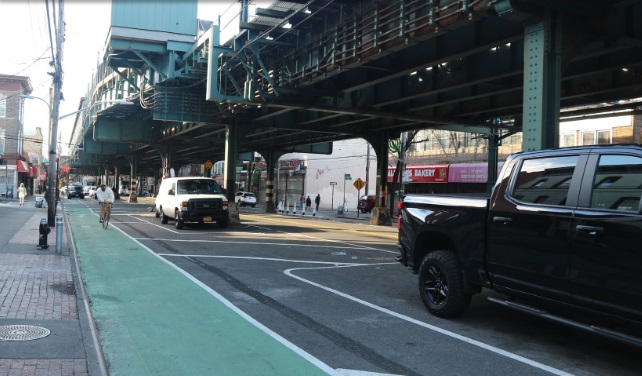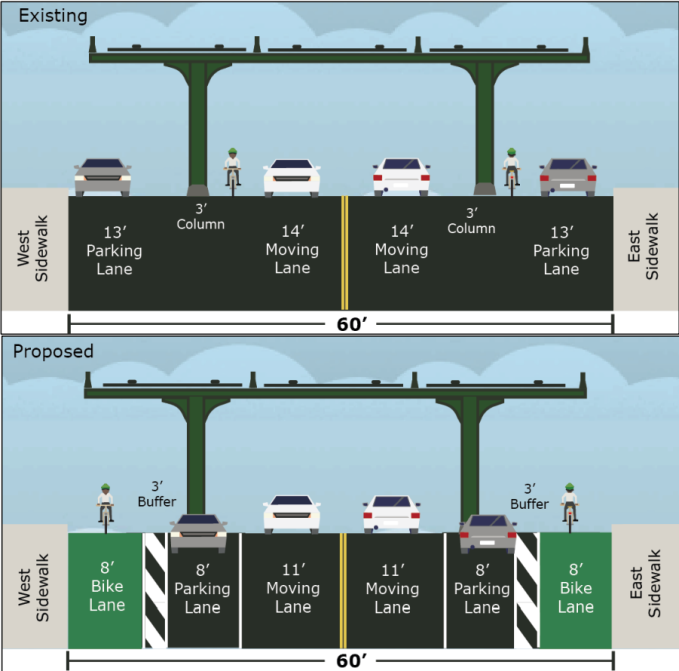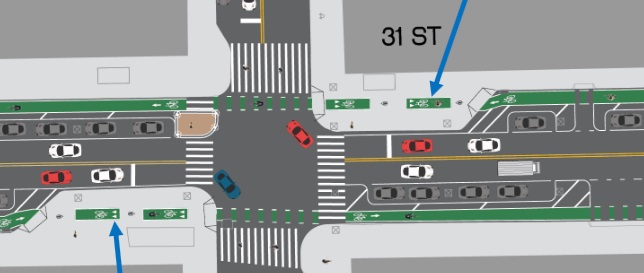
DOT proposal image for 31st Street, showcasing protected bicycle lanes and floating parking spaces. Via Change.org
April 18, 2025 By Shane O’Brien
More than 2,000 people have signed an online petition calling for protected bike lanes and “safety improvements” under the elevated subway tracks on 31st Street in Astoria—just one week after a group opposing the project produced a similar-sized petition.
The 31st Ave. Open Street Collective, which launched the dueling petition in support of the project, said the DOT’s plan to install a protected bike lane on both sides of 31st Street from 36th Avenue to Newtown Avenue would help address numerous safety issues along the corridor.
“Anyone who has tried to cross 31st Street knows how dangerous the current design is. Drivers swerve to avoid double-parked cars, and they cut corners as they fly through crosswalks,” bike lane advocates said in the petition.
They said the proposal, which would reduce the width of 31st Street’s moving lanes and parking lanes by three feet and five feet, respectively, in order to make room for the protected bike lanes, would significantly improve safety for cyclists along the mile-long stretch covered by the DOT plan.

Renderings for proposed bike lanes along 31st Street compared to the current layout of the corridor. Photo: DOT
The DOT also plans to add painted pedestrian islands at intersections to shorten pedestrian crossing distances and prevent motorists from cutting corners. The plan additionally bans parking at corners to boost visibility.

DOT mock-up proposal of 31st Street, overhead view, showcasing the proposed street redesign of the intersection of Broadway and 31st Street (overhead subway tracks omitted). Via Change.org
Supporters of the DOT plan argue that protected bike lanes are essential for improving safety along 31st Street, citing two traffic fatalities and 11 serious injuries reported on the corridor between 2020 and 2024.
The mile-long stretch of 31st Street—where the protected bike lanes would be installed—is among the most dangerous roads in Queens, according to DOT data, with a total of 178 injuries recorded on the corridor over the four-year period. DOT data cites “multiple instances” of cyclists getting “doored” – referring to when a cyclist collides with a car door that has been opened– while over 30% of pedestrian injuries have been caused by left-turn crashes.
However, a coalition of local business owners who launched the rival petition opposing the bike lane say that the DOT proposal would negatively impact local businesses while creating new safety issues by installing bike lanes through loading and delivery zones along 31st Street.
Several opponents of the bike lanes also spoke at Community Board 1’s monthly meeting on Tuesday, April 15, arguing that the project would strike a “devastating blow” to the local economy.
Opponents also raised concerns that the bike lane would threaten businesses along 31st Street, especially the King Souvlaki food truck, which has operated a curbside location along 31st Street for roughly 50 years. They said the food truck, which they described as a local institution, would be forced to relocate due to the redesign.
More than 3,000 people have signed the rival petition opposing the bike lane project since it was launched last week. The petition also accuses the DOT of ignoring community input while putting the proposal together.
Almost 20 bike lane supporters also spoke during Tuesday’s divisive CB1 meeting, stating that the bike lanes would improve safety along the corridor by protecting cyclists and preventing motorists from cutting corners.
Meanwhile, the supporting petition praised the DOT for “finally” addressing some of the safety concerns that have existed along 31st Street for years. The 31st Ave Open Street Collective also accused the coalition of local businesses of stoking “irrational fears based on misinformation and sometimes outright falsehoods.”
Ben Furnas, Executive Director of Transportation Alternatives, said the group was excited by the “groundswell” of support for the bike lanes in the recently-launched petition.
“We hope to see DOT move to reduce injuries and make 31st Street safe for everyone,” Furnas said.
The DOT similarly pushed back against the “baseless claims” of the opponents’ petition, stating that the proposal is a direct result of the Western Queens Street Safety Plan developed by local elected officials.
Agency officials also stated that the DOT continues to conduct outreach on all levels to help ensure that local businesses can load goods and receive deliveries.
“Our proposal will better organize traffic on 31st Street, where multiple people have been seriously injured or lost their lives in recent years, to improve safety for everyone while keeping vehicles moving,” a DOT spokesperson said. “This redesign would maintain the existing number of travel and parking lanes, with research showing designs like these successfully improve safety and support local businesses.”
DOT officials additionally stated that existing food trucks on 31st Street would be able to use a “floating parking lane” outlined in the proposal, which would allow them to operate similarly to how they are currently utilizing curbside space.
Officials further pointed to the results of another bike lane project in western Queens.
The DOT said that it found that businesses on Skillman Avenue in Sunnyside, where protected bike lanes were installed, reported a 12% increase in sales revenue along the corridor. They also noted studies stating that protected bike lanes reduce deaths and injuries for all road users by 16.1%, for pedestrians by 29.2%, and for senior-aged pedestrians by 39%.
John Surico, chairperson of the 31st Ave Open Street Collective, said the organization was “thrilled” to see the DOT propose “life-saving” measures along 31st Street.
“Anyone who walks, bikes, or drives down 31st Street knows how dangerous the stretch is,” Surico said in a statement.
The 31st Street protected bike lane proposal was not on the agenda for the latest CB1 meeting and was only discussed during the public comments section of the monthly meeting.
CB1 Chair Evie Hantzopoulos said Tuesday that the community board has asked the DOT to conduct a presentation on the project for the full board “down the line.”
Construction of the protected bike lanes is expected to begin in the summer.
